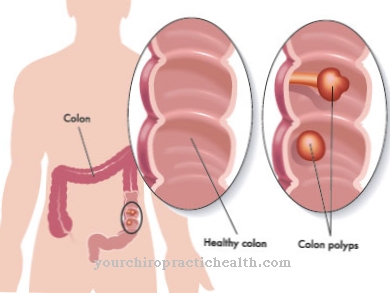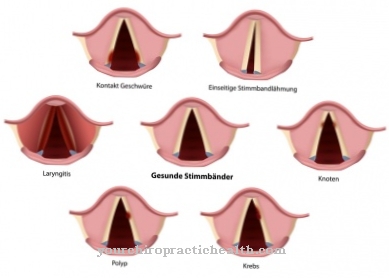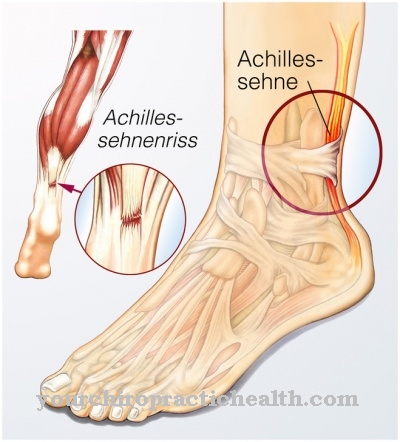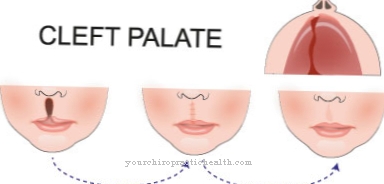Of the break of collarbone or Clavicle fracture is one of the most common, but at the same time harmless, fracture injuries. When the collarbone breaks, the clavicle (collarbone) breaks. This is the bone that connects the shoulder blade and the rib cage. A fall on an extended arm or shoulder is the most common cause of this fracture injury.
What is a broken collarbone?

© Henrie - stock.adobe.com
The Clavicle fracture is also commonly called break of collarbone known. A long bone, about as long as a hand, is the connection between the shoulder blade and the chest on the sternum. This bone is called the collarbone or clavicle. It is very common for this bone to break.
In the case of broken bones, only the broken spoke is more common. In most cases, children and adolescents are affected. The collarbone can break in different ways and in different places. Accordingly, broken collarbones are classified into four types.
Type 1 is defined as stable fractures that lie outside the ligaments. Type 2 are unstable breaks that are located between the outer ligaments and where the inner fragment protrudes upwards. In type 3 the break lies outside the outer ligament approaches. In type 4, the outer and soft bone coat is only displaced, but not severed. This type of collarbone fracture only occurs in children.
causes
A break of collarbone is always associated with a certain amount of violence. By far the most common causes are falls. Mostly a fall on the shoulders or on an outstretched arm takes place. Especially falls on the outstretched arm often occur in sports.
In addition to the falls, a fracture of the clavicle can also occur as a result of direct violence. Hitting the front shoulder area can cause a break.
But fractures of the collarbone also occur in traffic accidents, as the seat belt exerts a lot of pressure on the shoulder area in the event of an impact. Occasionally, an unfavorable position during childbirth can cause a broken collarbone in babies.
Symptoms, ailments & signs
The symptoms of a broken collarbone are very clear. In most cases, the two fracture ends of the bone move against each other, which leads to a palpable step on the collarbone. In many cases this is also visible. At the break point, bruises and swellings often form. More rarely, it is an open clavicle fracture. Here the ends of the bones have speared the skin and open wounds and bleeding occur.
Pain occurs when pressure is applied to the break point. In some cases, there is also pain when the head is turned because the head-turning muscle is attached to a piece of the collarbone. There is always pain when the arm is moved on the side of the body with a broken bone.
Those affected often put their arm in a relieving position. The arm is shifted slightly forward and lies against the body. This leads to hunched shoulders.
If the shoulder joint is moved, audible rubbing noises can also occur. This can also lead to pain. In rare cases, the fracture also injures the nerves or tendons in the area of the collarbone.
Diagnosis & course
A break of collarbone shows typical symptoms, so that the fracture can usually be diagnosed on the basis of these symptoms. If the collarbone fractures, the arm on the fracture side is automatically held in a relieving position. The shoulder is inclined slightly forward.
In addition, swelling and bruising in the fracture area often indicate a broken collarbone. In many cases there is a palpable and visible step at the break point. Pain occurs when pressure is applied to the affected shoulder or when the arm is moved.
If the affected shoulder joint is moved, a typical rubbing noise can often be generated at the fracture site. X-ray examinations or computed tomography are used to confirm the diagnosis. If a broken collarbone is diagnosed, it is important to check whether nerves or blood vessels are also affected by the injury. Usually a broken collarbone heals well and easily.
Complications
A broken collarbone can initially lead to severe pain, bruising and swelling in the arm, which are usually associated with restricted mobility. Occasionally, these restricted movements in the arm and shoulder persist for a long time. In people with certain pre-existing conditions, bone healing is delayed or completely absent.
The collarbone may also shorten, usually associated with reduced mobility of the affected arm. If the broken collarbone is not treated or treated inadequately, it can develop into a chronic disease. A surgical procedure is always associated with certain risks. The collarbone rarely becomes inflamed after the procedure or bleeding, wound healing disorders and the formation of scars occur.
If nerves are injured, sensory disturbances can occur. If muscles, joints or cartilage are injured, there is a risk of permanent restricted mobility. An inserted implant can fail, break or migrate and must then be replaced by a second procedure. Finally, allergic reactions to the materials and agents used can occur. Prescribed drugs can cause undesirable side effects and cause serious complications in unrecognized diseases.
When should you go to the doctor?
A fracture of the collarbone should of course always be treated by an appropriate doctor. Otherwise, full and timely recovery will not be possible. Affected people who experience such a fracture usually go to a doctor or hospital automatically. The pain of such a fracture is immense and unbearable, so that the nearest hospital or an emergency doctor is usually visited. In such a case, however, not only the first aid is very important, as a surgical intervention may be necessary.
This can ensure that the broken bone grows back together properly. Anyone who refrains from visiting the doctor in the later healing process is running a very high risk. The broken bone can grow together in a misalignment, which can lead to severe pain. So the following applies: The fracture of the collarbone must always be treated medically and with medication. This is the only way to guarantee complete healing. If this is not done, there is a risk of complications that cannot be properly restored afterwards.
Treatment & Therapy
A break of collarbone can be treated in two ways. In almost 98 percent of cases, the treatment is conservative therapy. However, surgical treatment may also be necessary. The method with which the fracture is ultimately treated always depends on the results of the X-ray examination.
With conservative treatment, patients are given a backpack bandage for around three to four weeks.This is a tension bandage that is placed around both shoulders and pulled taut and tight on the back. This will pull the shoulders back and position the broken bones in the correct position. In most cases, the treatment is followed by physiotherapy to restore full shoulder mobility.
Whenever blood vessels or nerves have been injured by the fracture or if the fracture is severely displaced, the collarbone fracture must be treated surgically. During the operation, injured vessels are treated and the break is fixed either with metal plates or screws. These have to be removed after half a year to a year. After the operation, the arm and shoulder are fixed with a so-called Gilchrist bandage and immobilized so that the broken collarbone can heal.
prevention
One break of collarbone cannot really be prevented. Usually it is a sports or accident injury. The necessary caution when exercising or in other situations where there is a risk of falling can at best reduce the risk of injury and thus prevent a broken collarbone.
Aftercare
If conservative therapy for the fracture of the collarbone is not enough, surgery can be carried out, which in turn requires follow-up care. The treatment is inpatient and the sensitivity of the affected arm is checked in the first few days after the procedure.
Among other things, the patient should move his elbow or form a fist. The drainage that is created during the operation can be removed after three days at the latest. Following the procedure, the surgical wound is thoroughly checked in the first few days.
In this way, possible wound healing disorders or infections can be detected early and treated accordingly. If the wound heals as planned, the sutures are removed after around 14 days. Physiotherapy exercises are another important part of the follow-up care for a broken collarbone. They serve to rebuild the affected muscle sections. In addition, the shoulder should be able to move fully again. As a rule, additional bandages do not have to be created.
X-ray examinations are carried out to monitor the progress. They are done after five to six weeks. Depending on the result, the patient should not lift or carry heavy loads with the treated arm for about six to eight weeks. A final x-ray check is done after three to four months. In order to treat the pain that still exists, the patient can be given appropriate medication.
You can do that yourself
In the case of a broken collarbone, the shoulder should be cooled first. This will relieve the pain and reduce the bruising. Rapid cooling through pads can support the healing process. After the treatment, the doctor's instructions should primarily be followed.
It is important to protect the affected shoulder. It is best to sleep on your back and with an orthopedic pillow to avoid further stress. Patients who put a lot of stress on their collarbone at work are best placed on sick leave. Various household medications can also be used to relieve pain. For example, ointments made from aloe vera, quark compresses or pain-relieving teas can be used. In consultation with the doctor, the healing of the fracture can be accelerated by targeted massages. Ideally, the patients can be instructed by a specialist. Otherwise, complications may arise that will affect the healing process.
A broken collarbone should be largely healed after three to four weeks. Until then, the medically prescribed medication must be taken and the suggested protective measures must be followed. If the symptoms persist or if you experience severe pain and restricted mobility, it is advisable to see a doctor. Various homeopathic remedies such as arnica or St. John's wort also help. It is best for patients to consult a suitable alternative practitioner.

























.jpg)


